Hollywood Legion Theater is Driven to Succeed
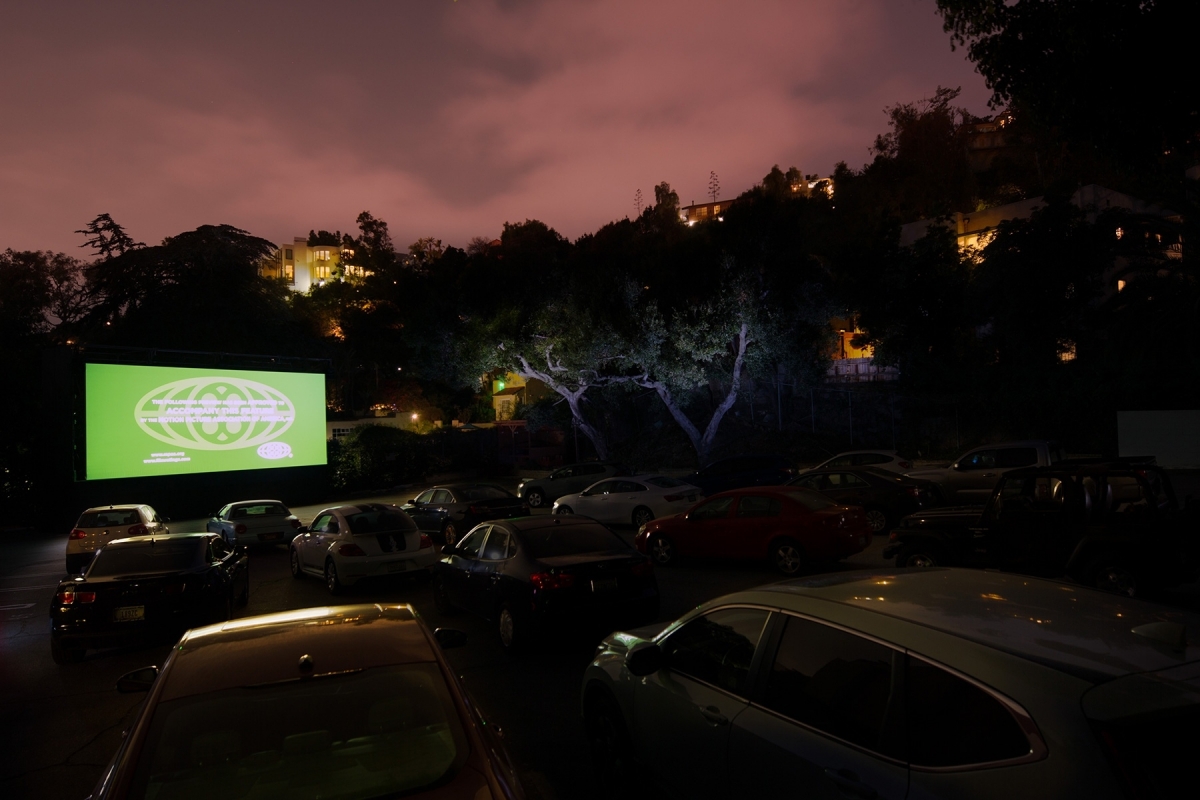
Photo by Taylor Umphenour
Originally built as a monument to World War I soldiers in 1929, the Hollywood Legion Theater at Post 43 went through a $4 million remodel and was reborn in 2018 as a world class cinema with the ability to project 35mm and 70mm films. “We did a number of private events as well as some partnership screenings that were open to the public and then COVID-19 hit in March of this year,” states Bill Steele, Theater Director, American Legion Hollywood Post 43. “The theater was shuttered and we had to figure a way out of this crisis. As I learned from being in the military, you either adapt or die. Taylor Umphenour [Chief Projectionist] had this great idea of converting the parking lot into a drive-in theater. That was in April and we’ve been working on it ever since. It has been a herculean effort to get this drive-in off the ground and operating, but we pulled it off.”
In order to establish the first drive-in theater in Hollywood, Steele and Umphenour put together a budget and proposal to present to the various Hollywood Legion committees. “The thing that started to bother me around the middle of April was that there was not a safe way for people to see films in the place where movies are made,” remarks Umphenour. “What we wanted to do was create a premier outdoor experience, with movies on the big screen seven nights a week.” Several companies that had done pop-up drive-ins around Los Angeles were approached. “It was hideously expensive to have someone come in, put up a screen and projection tower, rent the projector to us and take care of all of that stuff,” remarks Steele. “We decided to try and figure it out ourselves, develop the theater internally and partner with specific vendors for different components. Taylor had a lot of contacts with technical people who could be relied upon and were willing to help our effort. He brought Phil Burke on board for the screen rigging, and others. It took a village to make this happen, for sure.”
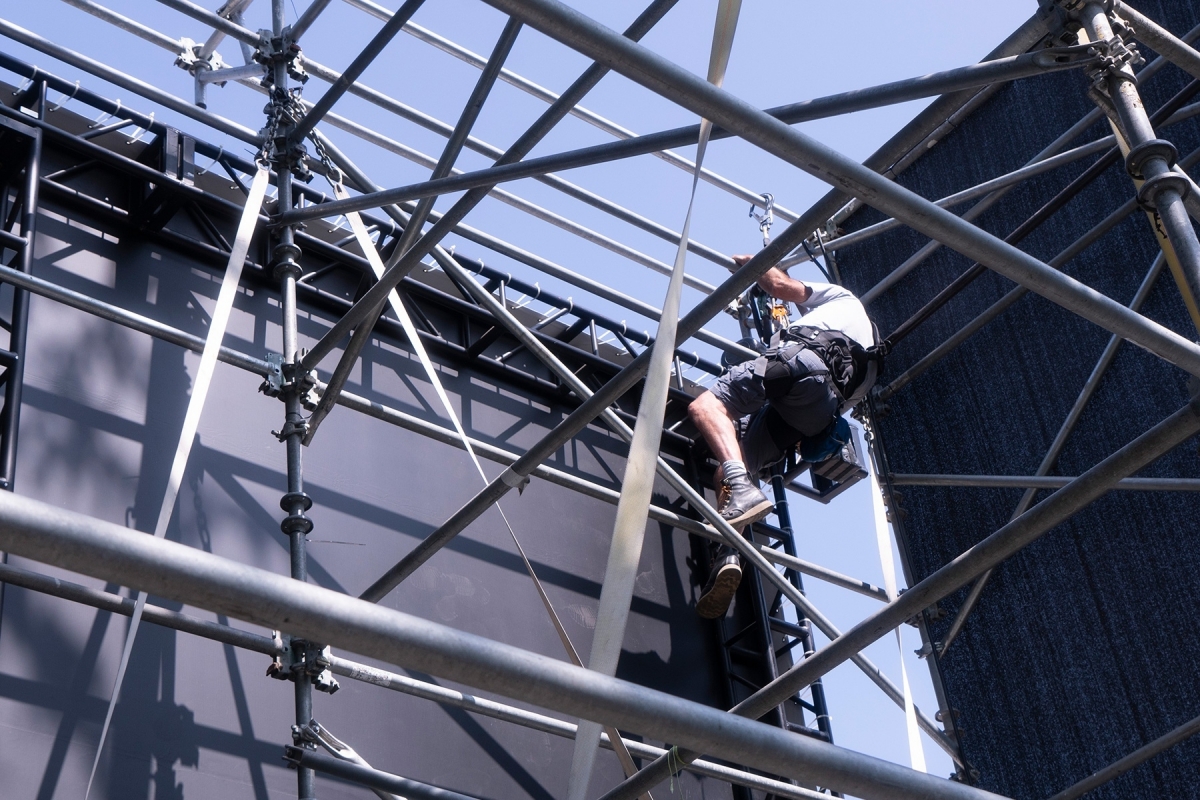
Photo by Scott DuVall
The general membership of 1,300 Legionnaires voted and approved the plan. “As you can imagine, trying to get something like this accomplished in the city of Los Angeles is a challenge at the best of times,” states Umphenour. “When you add a global pandemic into the mix, that’s when it gets complicated. Bill and I have had to turn ourselves into mini experts on permitting. We worked closely with Larry Vasquez in the Mayor’s Office, and with others at the city, to find a way to do this safely. We had to get the laws of Los Angeles amended because the city was not set up for movie theaters to be able to convert their parking lots into ongoing drive-ins seven days a week in the middle of a residential neighborhood.” The drive-in theater is situated at the foot of the Hollywood Hills. “There is a gentle slope to the lot and it would’ve been cost prohibitive to re-grade it. Car ramps were not an option for safety reasons. We ended up using the slope to help our sight lines by creating a tiered amphitheater-like system. When buying a ticket on the website, people declare what kind of a car or truck they’re going to arrive in. SUVs are in the back, midsize in the middle, with compact cars up front, so that each row can see over the row in front of them.”
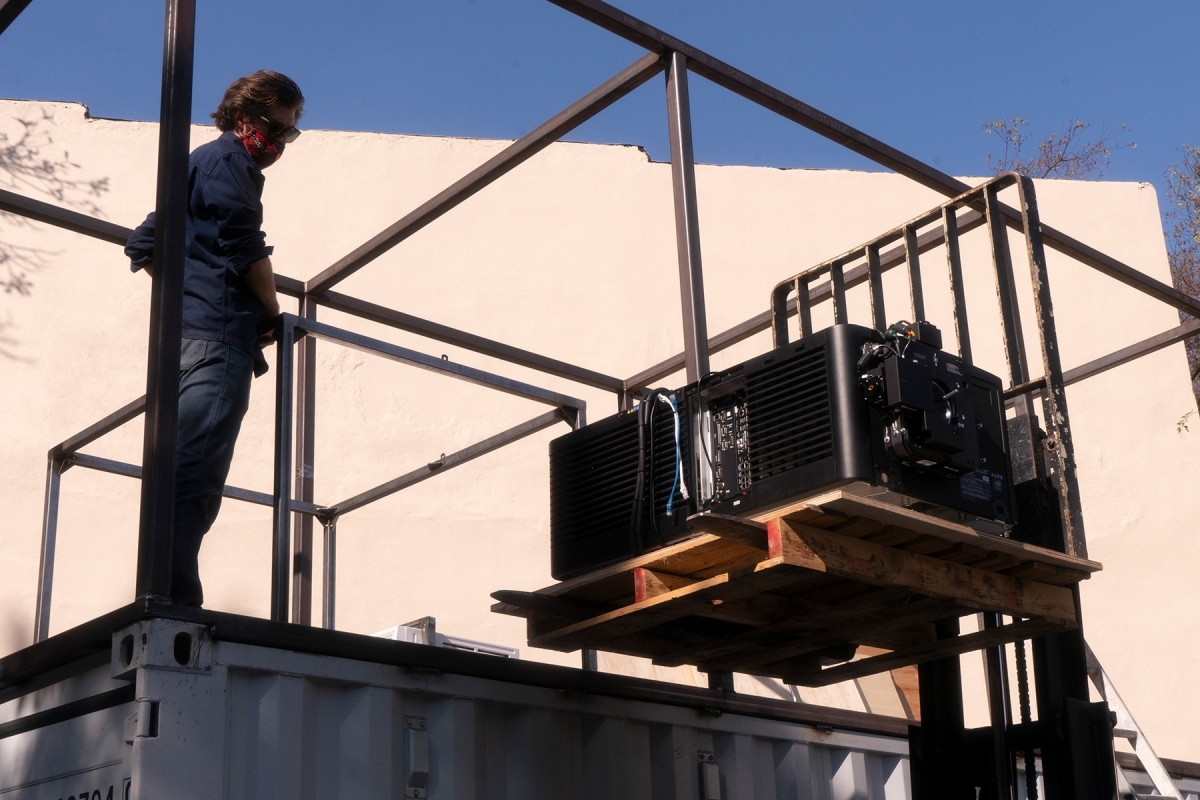
Photo by Scott DuVall
FM transmitted sound made purchasing a traditional acoustically transparent screen not necessary, so an unconventional polyvinyl material was turned into a 38-foot screen. “We had a special seamless screen constructed [which has the same luminosity as a cinema screen] made with grommets on the outside edges, and then laced that to a 38 foot width and 16 foot height custom-built box truss screen frame. That was lifted and rigged to a ballasted scaffold system that is the foundation for the cinema screen,” Umphenour said. “The sound goes through the car radio. You turn to 89.7 FM and then you can hear the movie.” The projection booth was custom-made by a metal fabrication artist named Joe Castillo. “Bill and I used a Conex box, which is like a shipping container, as the foundation for a projection booth and Joe built a welded steel frame around the top of that. It looks like a box for a magic act that contains a digital projector. There is a lamp exhaust fan and an air conditioning unit to keep the projector safe and cold.” Unlike the theater which has 482 seats, 30 cars can be accommodated amounting to anywhere from 75 to 120 patrons. Tickets cost $65 and include unlimited popcorn, one soda and one candy for all attendees. “And, of course, almost unheard of in Hollywood, free parking is included in the ticket price.”
Christening the drive-in on October 3rd was a screening of E.T. The Extra-Terrestrial followed by The Muppet Movie, Jaws, Ferris Bueller’s Day Off, Raiders of the Lost Ark, Ghostbusters, The Big Lebowski, Alien, The Thing, The Karate Kid, Rosemary’s Baby and a five-night run of Stevie Nicks 24 Karat Gold: The Concert. “Taylor and I share the programming duties and rely on our gut instinct,” reveals Steele. “So far, we only had one show that sold less than half the lot. Most of the shows have sold out. From what I’ve observed, the audience tends to veer a bit younger than I would have originally thought. We’re getting quite a few younger women in their 20s and 30s. We’ve had a lot of kids come to shows. When we showed Chinatown, we got an older crowd for that. It’s run the gamut.” Celluloid is seen as a means to expand programming and further build an audience. “If we are able to install 35mm projectors then we’ll attract the cineaste, the people who really love film and will come out to see an IB Tech print of McCabe & Mrs. Miller. We’ll be the only theatre anywhere on the entire West Coast that is going to offer that kind of filmgoing experience.”
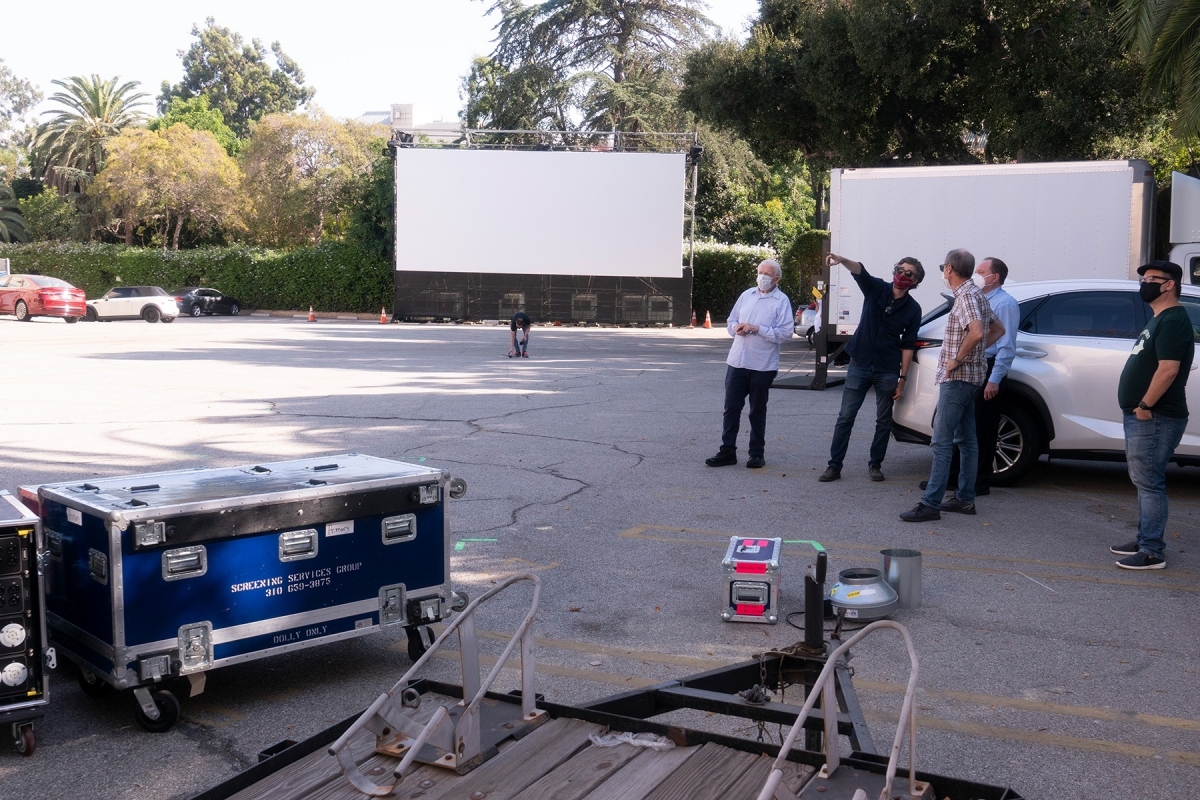
Photo by Scott DuVall
Donations to the theater’s Film Fund can be made through the official website for the Hollywood Legion Theater. “We have a 35mm and 70mm film system inside the theater and want to carry that legacy outdoors,” explains Umphenour. “Bill was the major advocate before I came onboard to bring film into the theater during the remodel. I started as an IMAX projectionist when I was 17 years old, ran a 35mm carbon arc art house cinema for 10 years, and ran 70mm dailies for Christopher Nolan out on location for Tenet. Film is the core of my craft as a projectionist.” Steele is equally enthusiastic about raising the necessary funds. “I have always been excited by the idea of an American Legion organization playing a role in film preservation. The studios have been supportive so far. The archivists and the people who manage the film libraries have been supportive of our efforts, especially Kodak, to run film at the drive-in. As far as I’m concerned, nothing touches the magic of the physical projected image. Being able to show films in the formats they were originally intended to be screened in has been a motivator for both Taylor and me for this entire project.”
If the fundraising is successful, the film projectors will be housed in a projection booth that has glass walls. “It will look like a Miesian box,” notes Steele. “People coming to the drive-in will be able to see the projectionist actually threading up the film and showing the movie. The whole tangible process of projecting 35mm film is something that most people aren’t familiar with.” Umphenour loves the theatricality of the idea. “This is where we are with cinema. We’re moving past our classic construction of a curtain opening and peering through a window into another world. With the drive-in, we’re actually reminding people that they are experiencing a show. The projectionist is the last of this long chain of performers who bring this show to an audience for their enjoyment. Putting the projection booth and the work of the 35mm film projectionist on display now allows the audience to be part of that experience.” The drive-in is not simply seen only as a transitional bridge. “If the permit is renewed and theaters reopen, we’re going to be able to offer simultaneous screenings in the theater and drive-in,” states Umphenour. “People who don’t feel comfortable coming back to theaters can come to the drive-in to see the same film that is going on in the theatre. How fun is that?!”
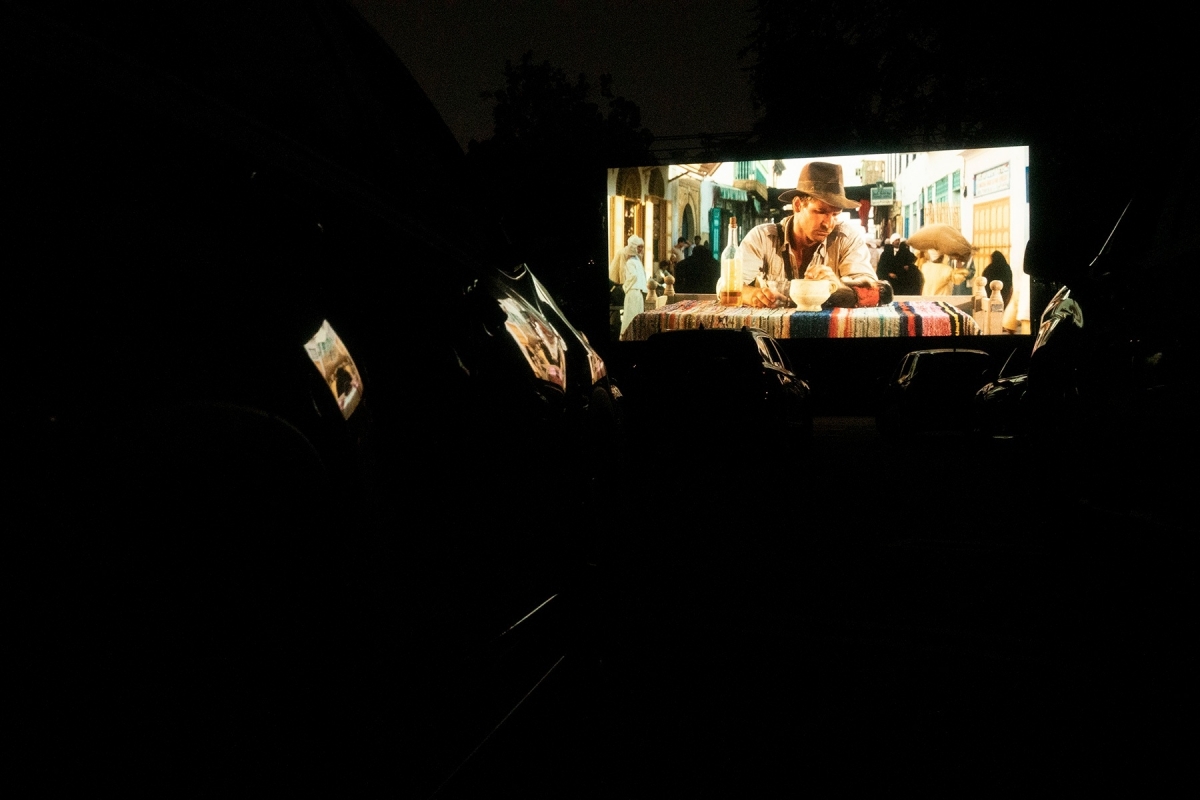
Amongst the movies screened is the "Raiders of the Lost Ark" which introduced the iconic character of Indiana Jones played by Harrison Ford. Photo by Taylor Umphenour.
The Hollywood Legion Theater stands to be in better position coming out of the pandemic. “The drive-in audience that we’re building incrementally night by night is going to end up being the foundation to being able to open up a full-scale film program in the theatre when we reopen,” remarks Umphenour. “What we were doing previously were one-off screenings. A special show once every two or three weeks. On the other side of this, we’ll get into doing a nightly film program with a core audience every night of the week.” Steele concurs with his colleague. “We’re essentially a calendar house running as a drive-in. We’re able to screen films seven nights a week and build a brand-new audience on the fly. Our goal is to ultimately bring that audience back into the theatre when we reopen indoor operations. The drive-in is acting as a vehicle, no pun intended, to enable us to do just that.”